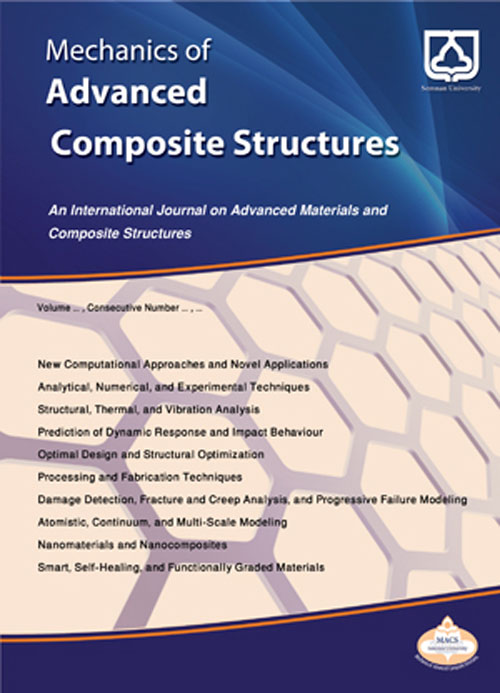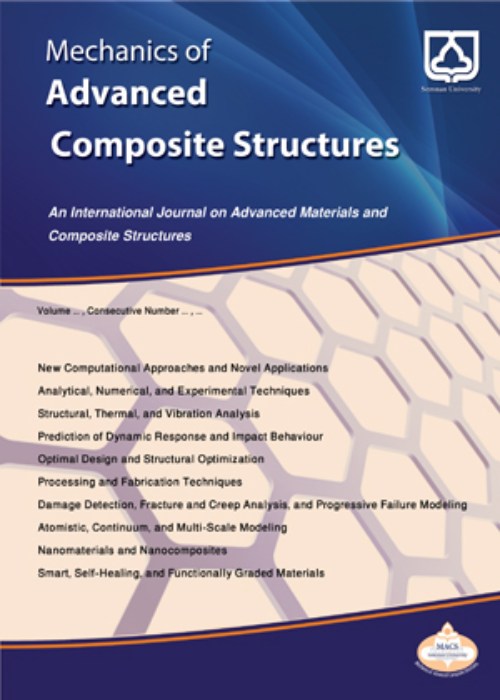فهرست مطالب

Mechanics of Advanced Composite Structures
Volume:2 Issue: 2, Winter and Spring 2015
- تاریخ انتشار: 1395/03/26
- تعداد عناوین: 7
-
-
Pages 73-78Nanostructured Al composites with 2.5 wt.% aluminum nitride (AlN) were fabricated by powder metallurgy using mechanically milled aluminum powder mixed in a planetary ball mill with different particle sizes of AlN (50 nm and 1 μm) as reinforcement. After 20 h milling, the powders were die-pressed uniaxially in a steel die and then sintered at 670 °C for 2 h. The morphologies and properties of the obtained powders were determined by scanning electron microscopy and X-ray diffraction analysis. The results have indicated that the crystallite sizes of the composites decreased by increasing the milling time, resulting in sizes of 46 nm and 55 nm for the composites containing large (1 μm) and small (50 nm) AlN particles, respectively. After 20 h of milling, the microhardness of the nanocomposites with AlN particle sizes of 1 μm and 50 nm were 101 and 122, respectively. The flexural strength of the composite containing smaller AlN particles (50 nm) was higher than that of the composite containing larger AlN particles (1 μm). The testing results have indicated that the strength and hardness properties of the composite containing smaller AlN particles are better than those of the composite with larger AlN particles.Keywords: Mechanical properties, Powder characteristics, Al, B4C nanocomposite, Mechanical alloying
-
Pages 79-93In the present study the free vibration analysis of the functionally graded rectangular nanoplates is investigated. The nonlocal elasticity theory based on the exponential shear deformation theory has been used to obtain the natural frequencies of the nanoplate. In exponential shear deformation theory an exponential functions are used in terms of thickness coordinate to include the effect of transverse shear deformation and rotary inertia. The nonlocal elasticity theory is employed to investigate the effect of the small scale on the natural frequency of the functionally graded rectangular nanoplate. The govering equations and the corresponding boundary conditions are derived by implementing Hamiltons principle. To show the accuracy of the formulations, the present results in specific cases are compared with available results in the literature and a good agreement is seen. Finally, the effect of the various parameters such as the nonlocal parameter, the power law indexes, the aspect ratio , and the thickness to lenghth ratio on the natural frequencies of the rectangular FG nanoplates is presented and discussed in detail.Keywords: Vibration, Functionally graded nanoplates, Nonlocal elasticity, Exponential shear deformation theory
-
Pages 95-111This study investigates the free vibration of the Two-Dimensional Functionally Graded Annular Plates (2D-FGAP). The theoretical formulations are based on the three-dimensional elasticity theory with small strain assumption. The Two-Dimensional Generalized Differential Quadrature Method (2D-GDQM) as an efficient and accurate semi-analytical approach is used to discretize the equations of motion and to implement the various boundary conditions. The fast rate of convergence for this method is shown and the results are compared with the existing results in the literature. The material properties are assumed to be continuously changing along thickness and radial directions simultaneously, which can be varied according to the power law and exponential distributions, respectively. The effects of the geometrical parameters, the material graded indices in thickness and radial directions, and the mechanical boundary conditions on the frequency parameters of the two-dimensional functionally graded annular plates are evaluated in detail. The results are verified to be against those given in the literature.Keywords: Functionally Graded Material, Generalized differential quadrature, Free Vibration, Annular plate
-
Pages 113-126In this study, using the non-local elasticity theory, the buckling and vibration analysis of triple- walled ZnO piezoelectric Timoshenko beam on elastic Pasternak foundation is analytically investigated under magneto-electro-thermo-mechanical loadings. Using the Timoshenko beam free body diagram, the equilibrium equation of Timoshenko nano-beam model is obtained and solved by Naviers method for a simply-supported nano-beam. The surrounding elastic mediums are simulated by Winkler and Pasternak models and interlayer forces are considered by Lenard-Jones potential. The effects of various parameters including the elastic medium, small scale, length, thickness, van der Waals force on the critical buckling load and non-dimensional natural frequency of triple- walled ZnO nano-beam are investigated. The results of this study show that the critical buckling load reduces with increasing the temperature change, direct electric field, magnetic field, and length of nanotube, and vice versa for the thickness of nanotubes, and two parameters elastic foundations. Also, the non-local critical buckling load and non-dimensional natural frequency of Timoshenko nano-beam are smaller than the local critical buckling load and non-dimensional natural frequency. The results can be useful for designing the smart nano-beam for MEMS and NEMS.Keywords: Non, local buckling, vibration analysis, Triple, walled ZnO piezoelectric, Timoshenko nano, beam, Elastic foundation, Magneto, electro, thermo, mechanical loadings
-
Pages 127-134In this study, the longitudinal and hoop tensile strengths of an industrial ±55° Glass Reinforced Epoxy (GRE) pipe with eighteen layers as well as the associated failure mechanisms are determined. To obtain the longitudinal and hoop tensile strengths values, three specimens are cut from the studied GRE pipe in each direction. A comparison is done between both the strength values, and the fracture pattern of the specimens is studied. Determining the different failure mechanisms which are created during both of the tests, the acoustic emission technique is used. The acoustic emission energy as an important damage parameter in determining the different failure mechanisms of the specimens is depicted for both of the tests and is related to the obtained results from the stress-time curve. A high magnification camera is used to verify the failure mechanisms characterized by the acoustic emission method.Keywords: GRE composite pipe, Longitudinal strength, Hoop strength, Acoustic emission, Failure mechanisms
-
Pages 135-144In this study, the buckling behavior of moderately thick Carbon Nano-Tube (CNT)-reinforced spherical composite panels subjected to both uniaxial and biaxial loads is examined. The uniform and various kinds of functionally graded distributions of the CNT are considered. The mechanical properties of the nanocomposite panels are estimated using the modified rule of mixture. Based on the first-order shear deformation theory and the von Karman-type of kinematic nonlinearity, the governing differential equations are derived and the solutions are determined using Galerkins method. The suggested model is justified by a good agreement between the present results and those reportedin the literature. The numerical results are performed to elucidate the influences of volume fraction, aspect ratio, thickness ratio and side-to-radius ratio on the critical buckling loads of the spherical nanocomposite panels. One of the main contributions of the current study is to investigate the effectiveness of functionally graded distributions.The effectiveness of functionally graded distributions with respect to various parameters are also investigated.Keywords: buckling, Carbon nanotube, reinforced, Nanocomposite, Spherical panel
-
Pages 145-150The dynamic instability regions of composite laminated skew flat plates subjected to uniform in-plane axial end-loading are investigated. The in-plane loading is assumed as a combination of a time-invariant component and a harmonic time-varying component uniformly distributed along two opposite panel ends width. In case of some loading frequency-amplitude pair-conditions, the model is subjected to instabilities. The dynamic instability margins of the skewed flat panel have been extracted using a developed semi-analytical finite strip formulation. The method has been developed based on a full-energy approach through the principle of the virtual work. The effects of thickness have been included by utilizing a third-order Reddy type shear deformation theory. The effects of boundary conditions as well as geometry on the instability load-frequency regions are derived using the Bolotin's first-order approximation. In order to demonstrate the capabilities of the developed method in predicting the structural dynamic behavior, some representative results are obtained and compared with those in the literature wherever available.Keywords: Parametric instability, Finite strip method, Skew plate, Third order shear deformation theory


